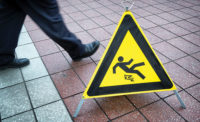Slips, trips and falls are a major challenge for safety professionals. Not only are they responsible for 25% of all occupational injuries that require time off work, but they’re also notoriously difficult to solve.
So how do you reduce the number of slips, trips and falls in the workplace? To answer that question, you need to know what causes them in the first place—and it’s not what you think.
Most traditional solutions to slips, trips and falls focus on physical factors like wet floors, tripping hazards and walking speed. There are three major ways of dealing with the physical causes of slips, trips and falls:
- regular maintenance
- rules and procedures
- proper equipment and guards
Establishing detailed housekeeping procedures and then providing products like anti-slip cleaning products and high-traction mats will go a long way towards helping keep your workers on their feet.
But slip, trip and fall incidents are still prevalent despite these solutions being widely available. And you don’t even need an external trip hazard to fall—people trip over their own feet all the time.
In addition to physical factors there’s another major contributor to slips, trips and falls: human factors. These include:
- distraction (like texting while walking)
- walking too quickly
- not looking where you’re walking
These are best addressed with human factors training that builds and reinforces important habits like maintaining a safe walking speed, approaching blind corners cautiously and keeping an eye out for trip hazards. Proper human factors training should address distraction and give workers the wherewithal to stay focused on where they’re walking.
The most comprehensive solution to slips, trips and falls is combing physical solutions with human factors training. A well-rounded approach will help you drastically cut down on how often your employees are injured by a same-level fall, and the human factors training will provide spillover benefits to other areas of your safety program too.


